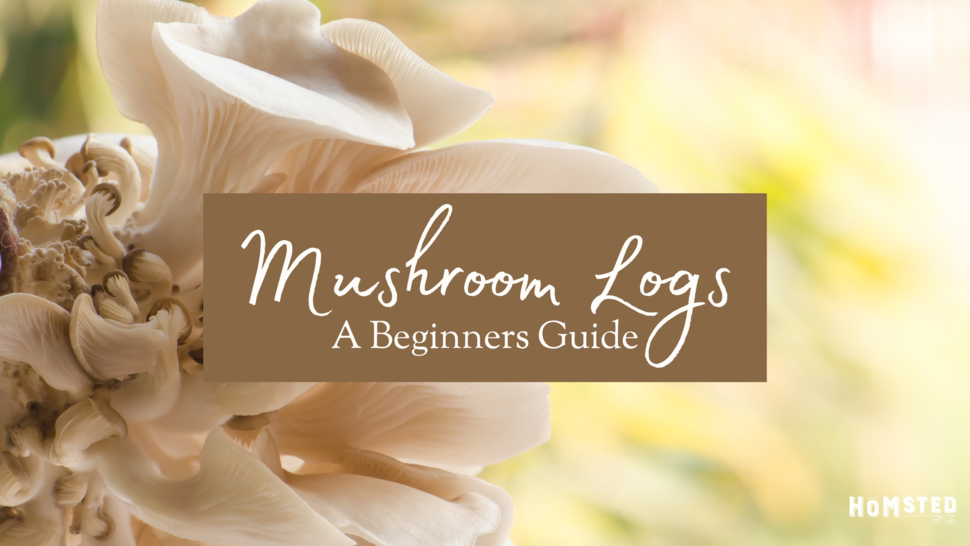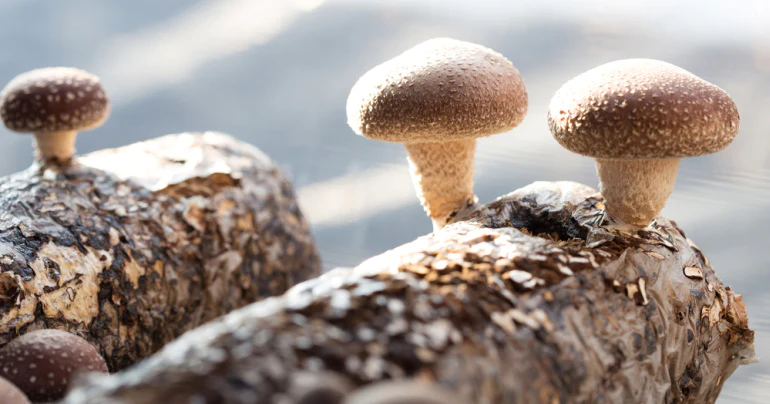Mushroom Logs: The Beginners Guide

What is a Mushroom Log?
Mushroom logs are one of the many ways to grow mushrooms in a controlled outdoor environment. Logs have the advantages of (1) needing almost no preparatory work, (2) being very easy to care for, and (3) being scalable. Generally, mushrooms logs need little more than time and occasional water to start producing. Once they do start producing, they generally do so for at least a couple of years. Regarding scalability, you can have just a single log in a small garden, or you can have hundreds of logs as many commercial operations do.
Mushroom logs start as logs that are greater than 3 inches in diameter and cut to length. It is important to start with either live trees or freshly dead trees that have not yet fallen. The reason for this is that trees that have been dead for some time have probably already been inoculated by wild and potentially dangerous mushroom spores. Fresh logs allow you to start with a ‘clean slate’. The type of wood is an important consideration as mushrooms can be very picky about which type of wood they grow on. The logs are then drilled every few inches. The holes are packed with (1) colonized wooden plugs, or (2) colonized sawdust. This step serves to inoculate the log with the desired species of mushroom. Those filled holes, along with the ends of the logs, are then sealed with a wax. The wax serves two purposes: it seals the log to minimize moisture loss and it keeps wild mushrooms from easily taking over the log.
Mushroom Species

Blue Oyster
Difficulty: Beginner
Blue oysters are a great way to start with mushroom growing. They grow on a variety of wood types. With this log we use locally sourced, fresh-cut aspen. They produce a lovely blue or gray cap. Blue Oysters tend to thrive in cooler weather. They tend to fruit naturally as the temperatures drop.

Shiitake
Difficulty: Beginner
Shiitakes are another easy mushroom to grow. However, they can be pickier about wood type. For these logs kits we use a locally sourced, fresh-cut gamble oak. Shiitakes grow a brown cap and are slightly more tolerant to a wider range of temperatures.
Steps when using our pre-spawned mushroom logs
INITAL COLONIZATION:
Initial colonization of your mushroom logs is already underway, but may take an additional 6-12 months. This time depends on temperature, log size, moisture levels, and the time since made. Throughout this initial colonization, we recommend placing you log(s) horizontally on a pair of bricks or stones. This keeps your logs off the ground where wild mushrooms will have an easier time colonizing the log and competing with your desired mushroom species. You’ll know initial colonization is complete when you start to see mycelium appear on the ends of the logs (see photo). It is also important to occasionally water your log(s) so as to keep them from drying out. Occasional dryness will not kill the mushrooms, but it will drastically slow their colonization. Keeping your mushroom logs in a shady corner of your gardens, or in a shady and watered section of your lawn.
FRUITING:
After initial colonization, it is time to expect some mushrooms! You can leave your logs where they are and expect repeated fruiting. However, we recommend the following technique: Scrape or cut the beeswax coatings off the end of the logs. Then, plant your log vertically in about 3-6” of soil. It should look like a tree that has been cut off a couple of feet off the ground. Select a location where it is mostly shaded and the soils are regularly watered or naturally moist. When you ‘plant’ your logs, you are allowing the log to wick moisture from the soil and through the log. It then evaporates from the top of the log, thus keeping your logs continually moist and a happy place for your mushrooms to thrive.
*BE SURE TO CORRECTLY IDENTIFY ANY MUSHROOM YOU PLAN TO EAT, EVEN IF IT GROWS ON THESE MUSHROOMS LOGS*
On rare occasions, wild and dangerous mushroom strains can co-colonize your logs.
FAQs
What about winter?
Your mushrooms logs will fine through the winter. Although you shouldn’t expect any fruiting, they will be dormant but happy. A blanket of snow is always nice as it will keep them from drying out.
How often should I water my mushroom logs?
Unless your logs are going in a particularly arid environment, you might be surprised how little water your logs will need. Generally, watering once or twice a week is sufficient. Keep in mind, you can overwater your logs. Frequent light waters can impede oxygen turnover in your log, which is not a good thing. For this reason, longer and more periodic is preferred. Optionally, you can submerge your colonizing logs in water for no more than 24 hours once a month or less.
How long will my mushroom log last?
Once your mushrooms start fruiting, you can expect 2 to 6 years of fruiting. The smaller the log, the quicker they will degrade. Also, the hardwoods will outlast the softwoods.

A fully colonized mushroom log showing myceliated ends.

A mushroom log with wax removed from the ends and planted vertically after full colonization.
Want to make your own mushroom log?
Great! We’ve got what you need. Our mushroom log kits have all the tools and supplies you need to create your own mushroom log. You’ll just need to supply a log or two and a drill. These kits come with a voucher for 100 colonized wood plugs; enough for a couple of small logs (3-4” diameter, 3’ long) or one large one (~6” diameter and 4’ long).




